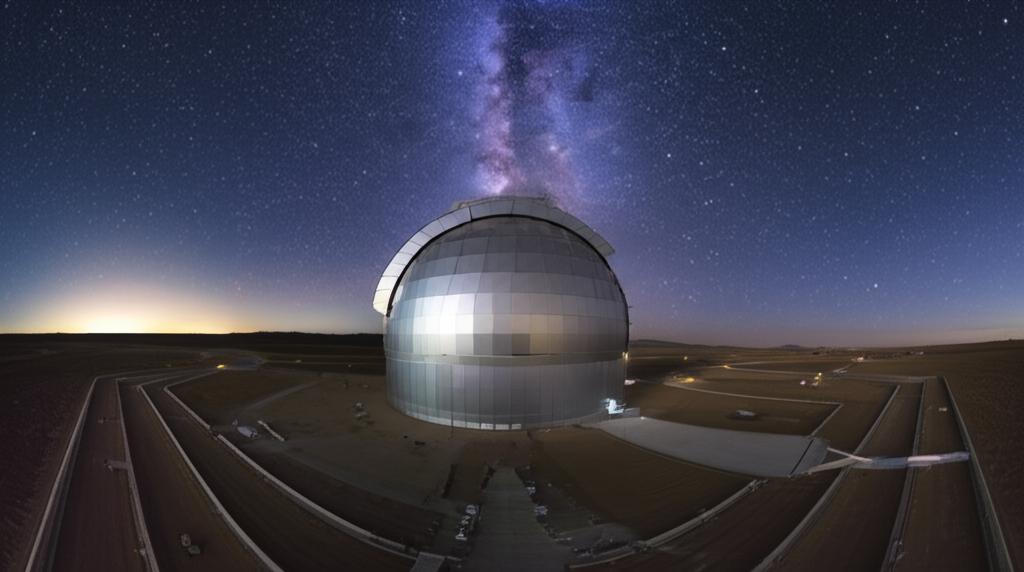Poised atop Cerro Pachón in Chile, the Vera C. Rubin Observatory is nearing the commencement of its ambitious ten-year mission: the Legacy Survey of Space and Time (LSST). This undertaking promises to revolutionize multiple fields of astronomy by creating the most extensive map and "movie" of the night sky ever produced.
Telescope and Camera: A Powerful DuoAt the heart of the observatory lies the 8.4-meter Simonyi Survey Telescope. Its innovative three-mirror anastigmat design provides an exceptionally wide 3.5-degree field of view, allowing it to capture vast swathes of the sky efficiently. The telescope's compact structure enables rapid movement, essential for surveying the entire visible southern sky every few nights.
Mounted on this telescope is the groundbreaking LSST Camera (LSSTCam), the largest digital camera ever constructed for astronomy. Weighing over 3 tons and comparable in size to a small car, this instrument boasts a staggering 3.2-gigapixels resolution spread across 189 CCD sensors arranged in 21 "rafts". Its focal plane spans 9.6 square degrees. The camera utilizes six optical filters (u, g, r, i, z, y) covering wavelengths from 320 to 1060 nm. Capable of reading out its entire massive array in just two seconds, the LSSTCam is designed for rapid, repeated imaging. This crucial component arrived at the observatory site in May 2024 and was successfully installed on the telescope structure in March 2025, marking a major milestone.
Supporting SystemsTo ensure the highest quality data, Rubin Observatory employs supporting instrumentation. A dedicated 1.2-meter Auxiliary Telescope (AuxTel), equipped with the LSST Atmospheric Transmission Imager and Slitless Spectrograph (LATISS), continuously measures atmospheric conditions. This information is vital for calibrating the LSST data. Furthermore, a sophisticated data management system is in place to handle the immense data flow. It is designed to process approximately 20 terabytes of raw image data each night, issuing public alerts for detected changes in the sky within 60 seconds.
The Legacy Survey of Space and Time (LSST)The observatory's primary task is conducting the LSST for a decade. The main survey will cover roughly 18,000 square degrees of the southern sky, with each patch being visited around 825 times across the six filters. The survey strategy involves taking pairs of 15-second exposures. Including special programs like Deep Drilling Fields which receive more intensive observation, the total surveyed area will approach 25,000 square degrees. Over its ten-year lifespan, the LSST will gather an unprecedented dataset totaling approximately 500 petabytes of images, yielding a final science-ready catalog database of about 15 petabytes. This data will be made available to the scientific community through annual releases.
Driving Science: Four Key PillarsThe LSST is specifically designed to address four fundamental science areas:
- Probing Dark Energy and Dark Matter: By mapping billions of galaxies and measuring their shapes and distributions over cosmic time, Rubin will shed light on the mysterious nature of dark energy driving cosmic acceleration and the distribution of invisible dark matter. Techniques employed will include weak gravitational lensing, observing large-scale structures like Baryon Acoustic Oscillations (BAO), analyzing Type Ia supernovae as standard candles, and studying the distribution and masses of galaxy clusters.
- Taking an Inventory of the Solar System: Rubin's wide, deep, and frequent observations will dramatically increase the catalog of small bodies within our Solar System. It aims to detect a significant fraction (potentially 60-90%) of potentially hazardous asteroids larger than 140 meters. It will also map numerous Kuiper Belt Objects, providing insights into the Solar System's formation and evolution, and potentially aiding in the search for hypothesized distant planets like Planet Nine.
- Exploring the Transient Optical Sky: The LSST will provide a dynamic view of the universe, capturing objects that change brightness or position over time. This includes tracking variable stars, discovering various types of supernovae shortly after explosion, and searching for new and exotic transient events. Its ability to quickly issue alerts will enable rapid follow-up observations by other telescopes and facilitate the identification of optical counterparts to events detected by gravitational wave observatories.
- Mapping the Milky Way: The survey will generate a vast dataset on stars within our own galaxy, allowing astronomers to study the Milky Way's structure, formation history, and how it has been shaped by mergers with smaller galaxies over billions of years.
Following engineering first light with a smaller commissioning camera in October 2024 and the installation of the main LSST Camera in early 2025, Rubin Observatory is in its final testing and integration phase. System First Light, utilizing the main LSST Camera, is anticipated in July 2025. Full survey operations are expected to commence later in 2025, approximately 4-7 months after achieving System First Light. The observatory is on the cusp of beginning its decade-long quest, promising a new era of discovery across astrophysics and cosmology.

